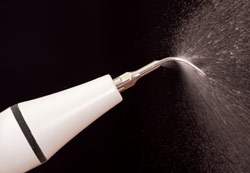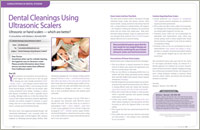 When it comes to cleaning your teeth, few dental instruments can match the power and speed of an ultrasonic scaler. Ultrasonic equipment was first used in dentistry back in the 1950s; today, ultrasonic scaling is a mature and time-tested technology. In experienced hands, these high-tech instruments can disrupt and flush away bacteria along with hard deposits that your toothbrush can't touch — and they can even help moderately stained teeth look brighter.
When it comes to cleaning your teeth, few dental instruments can match the power and speed of an ultrasonic scaler. Ultrasonic equipment was first used in dentistry back in the 1950s; today, ultrasonic scaling is a mature and time-tested technology. In experienced hands, these high-tech instruments can disrupt and flush away bacteria along with hard deposits that your toothbrush can't touch — and they can even help moderately stained teeth look brighter.
Chances are you may already be familiar with ultrasonic scalers — or at least, your teeth are. They are the tools of choice for many dentists and dental hygienists. Why? Because they're so good at removing the buildup of stains, dental plaque and calculus (also called tartar) from the crown (above the gum) and root (below the gum) surfaces of the teeth. Since the removal of plaque and calculus helps eliminate harmful bacteria beneath the gum line, cleaning with an ultrasonic scaler (sometimes called "root debridement") is a primary means for preventing gum disease.
How Do Ultrasonic Scalers Work?
 There are currently two main types of ultrasonic scalers (the piezoelectric and magnetostrictive varieties), but both work the same way — electromagnetic forces coursing through the hand-held unit cause its tiny tip to vibrate rapidly. However, each has a different type of motion: The magnetostrictive variety moves in an elliptical motion, while the piezoelectric variety moves in a linear motion. The vibrations are so fast for both types — about 25,000 to 45,000 times per second — that they fall into the ultrasonic range.
There are currently two main types of ultrasonic scalers (the piezoelectric and magnetostrictive varieties), but both work the same way — electromagnetic forces coursing through the hand-held unit cause its tiny tip to vibrate rapidly. However, each has a different type of motion: The magnetostrictive variety moves in an elliptical motion, while the piezoelectric variety moves in a linear motion. The vibrations are so fast for both types — about 25,000 to 45,000 times per second — that they fall into the ultrasonic range.
With its vigorous, repetitive motion, the tip is easily able to break up hardened deposits on the tooth without damaging it. Some tips are so fine that they can be used not only on the crown surfaces of teeth, but on the roots as well. The ultrasonic scaler can rapidly remove tough stains and tartar, meaning less time for the patient in the chair, and less fatigue for the clinician. In fact, the tool's tip moves so quickly that it must be cooled by a constant stream of liquid, a process called lavage.
Besides keeping the tip from overheating, lavage constantly flushes debris away from the area under treatment. And it has an additional benefit: As water passes the vibrating tip, it creates millions of tiny bubbles, an effect called cavitation. This has been shown effective in rupturing the walls of bacterial cells and disrupting the favored environment of harmful bacteria. Antimicrobial agents can even be added to the lavage water if needed.
Who Can Benefit from Ultrasonic Scaling?
Generally speaking, anyone who needs a deep cleaning of the teeth, both above and below the gum line, can benefit from ultrasonic scaling. This treatment is especially important as a preventive measure for people who may be prone to periodontal (gum) disease. In many instances, ultrasonic scalers are used in combination with traditional hand scalers for a thorough cleaning.
If you have titanium implants, composite or porcelain restorations, or areas of demineralization on your teeth, be sure to let us know before your treatment. There may be special tips that are suitable for use in these circumstances. Also, individuals with cardiac pacemakers or hypersensitive teeth should always alert us beforehand so precautions can be taken.
In terms of effectiveness, safety and patient comfort, ultrasonic scaling remains one of the best methods of non-surgical periodontal therapy.
Related Article

Dental Cleanings Using Ultrasonic Scalers Rapidly changing technology has revolutionized periodontal therapy with the integration of power scaling techniques resulting in improved clinical outcomes, patient comfort, and reduced time and physical demands on clinicians... Read Article

